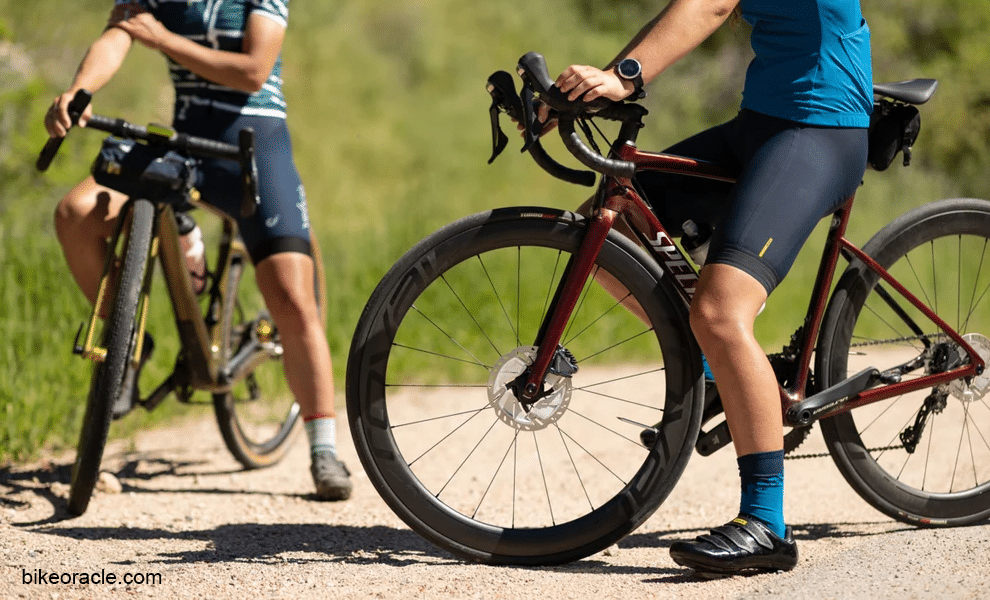Can Road Bikes Go On Gravel?

In recent years, gravel riding has gained significant popularity among cyclists seeking new adventures beyond traditional paved roads. This growing interest has sparked a common question: Can road bikes go on gravel surfaces? In this article, we will delve into the world of road bikes and gravel riding, exploring the compatibility of road bikes with off-road terrains.
Understanding Road Bikes At A Glance
A road bike is a lightweight and nimble bicycle designed primarily for riding on smooth paved roads. These bikes feature drop handlebars, skinny tires, and a more aggressive riding position.
Lightweight design: Road bikes are renowned for their lightweight construction, allowing for greater speed and agility on paved roads.
Drop handlebars: Road bikes feature drop handlebars that offer multiple hand positions, promoting aerodynamics and efficient riding posture.
Skinny tires: Road bikes are equipped with narrow, high-pressure tires that minimize rolling resistance, enabling faster speeds on smooth surfaces.
Aggressive geometry: The geometry of road bikes is designed to optimize power transfer and forward momentum, enhancing overall performance.
Key Features and Characteristics
Speed-focused design: Road bikes prioritize speed, allowing riders to achieve higher average speeds and excel in road racing or long-distance rides.
Efficient power transfer: The rigid frame and geometry of road bikes ensure efficient power transfer from the rider’s legs to the pedals, maximizing forward propulsion.
Responsive handling: Road bikes offer precise and nimble handling, allowing riders to navigate corners and turn with ease.
Aerodynamic advantage: The streamlined design of road bikes reduces wind resistance, enhancing efficiency and speed.
Pros and Cons of Road Bikes
Pros:
Speed: Road bikes excel in speed, making them ideal for riders seeking fast-paced rides and road racing.
Efficiency: The lightweight construction and efficient power transfer of road bikes contribute to their high efficiency on paved roads.
Agility: Road bikes offer responsive handling, allowing riders to navigate turns and corners smoothly.
Aerodynamics: The aerodynamic design of road bikes minimizes wind resistance, enabling riders to maintain higher speeds with less effort.
Cons:
Limited off-road capabilities: Road bikes are designed for smooth roads and may struggle on gravel, dirt, or uneven surfaces.
Lack of tire clearance: The narrow tire clearance of road bikes restricts their ability to accommodate wider tires, limiting their traction and stability on rougher terrains.
Harsh ride quality: Road bikes prioritize efficiency and speed, often resulting in a stiffer and less comfortable ride compared to bikes with suspension systems.
Vulnerability to damage: The lightweight and delicate nature of road bikes makes them more susceptible to damage from rough surfaces or impacts.
Limited storage capacity: Road bikes typically lack mounting points for racks or panniers, limiting their suitability for carrying cargo or embarking on extended tours.
Note: While road bikes have limitations for off-road riding, advancements in gravel bikes have emerged as a specialized option that combines elements of road and mountain bikes, offering improved off-road capabilities.
Gravel Riding Explained In Detail
Gravel riding involves venturing off the beaten path and exploring unpaved surfaces such as gravel roads, fire trails, and dirt paths. It offers a unique blend of endurance, adventure, and exploration. Gravel riding has gained popularity due to its accessibility, the opportunity to discover beautiful landscapes, and the sense of freedom it provides.

Benefits and challenges of gravel riding
Benefits
- Accessible and versatile form of cycling for riders of various skill levels
- Opportunities to explore scenic landscapes and remote areas
- Sense of adventure and freedom in discovering new routes
Challenges
- Unpredictable terrain with varying levels of roughness and surface conditions
- Limited traction on loose gravel and uneven surfaces
- Potential for increased vibration and discomfort compared to paved roads
Gravel bikes vs. other types of bikes
Gravel bikes
Designed specifically for gravel riding with versatile capabilities
Features wider tire clearances for accommodating gravel-specific tires
More relaxed geometry for added stability and comfort on rough terrains
Road bikes
Primarily designed for riding on smooth paved roads
Narrower tire clearances and aggressive geometry for optimal speed and efficiency
Limited suitability for challenging gravel conditions, but can handle certain gravel surfaces with modifications.
Mountain bikes
Built for off-road trails and rugged terrains
Wide tires with aggressive tread patterns for enhanced traction
Heavy and more robust compared to gravel bikes, providing superior stability but sacrificing speed on gravel roads
Cyclocross bikes
Intended for cyclocross racing, which involves a mix of paved and off-road surfaces
Similarities to gravel bikes with wider tire clearances and more aggressive geometry
Generally lighter and more responsive than mountain bikes, offering a balance between speed and off-road capabilities
Can Road Bikes Handle Gravel?
While road bikes are not specifically designed for gravel riding, they can handle certain gravel surfaces to a certain extent. However, several factors must be considered to determine their suitability for off-road adventures. Key considerations include tire clearance and width, frame material and design, and suspension options.
Factors to Consider
Tire Clearance and Width
Road bikes typically have narrower tire clearances compared to gravel bikes.
Limited tire clearance may restrict the ability to fit wider, more robust gravel tires.
Adequate tire width is essential for better traction and stability on gravel surfaces.
Frame Material and Design
Road bike frames are designed for maximum efficiency on smooth paved roads.
The frame material, such as carbon fiber or aluminum, affects the bike’s weight and durability.
Road bike frames may lack the additional reinforcement and robustness found in gravel bike frames.
Suspension Options
Road bikes usually do not feature suspension systems, as they prioritize efficient power transfer on paved roads.
Lack of suspension can result in a harsher ride on gravel, transmitting more vibrations and impact to the rider.
Challenges Road Bikes Face on Gravel
Limited Tire Grip: Road bike tires, with their slick or semi-slick design, may struggle to provide sufficient traction on loose gravel surfaces.
Increased Risk of Punctures: The narrow tires of road bikes are more susceptible to punctures and damage from gravel and debris.
Reduced Stability: Road bike’s aggressive geometry and lightweight frames may compromise stability on uneven or rough terrain.
Lack of Comfort: The absence of suspension and limited shock absorption can lead to a less comfortable ride on gravel.
Comparing Road Bikes and Gravel Bikes
Tire Selection: Gravel bikes offer wider tire options, typically ranging from 32mm to 45mm or more, providing enhanced traction and stability on gravel surfaces. Road bikes typically have narrower tires, usually around 23mm to 28mm.
Frame Design: Gravel bike frames often feature more relaxed geometries, allowing for a more comfortable riding position and stability on rough terrains. Road bike frames prioritize aerodynamics and aggressive positioning for speed on smooth roads.
Additional Features: Gravel bikes may include mounts for fenders, racks, and water bottle cages to support longer adventures and backpacking. Road bikes tend to have a minimalist design without such provisions.
Suspension: Gravel bikes may feature front suspension systems or incorporate rear suspension for enhanced comfort and shock absorption. Road bikes generally lack suspension systems.
By considering factors such as tire clearance, frame design, and suspension options, it becomes evident that road bikes face challenges when venturing onto gravel surfaces. While road bikes can handle certain gravel conditions to a certain extent, purpose-built gravel bikes are specifically designed to excel in off-road adventures.
Making Road Bikes Gravel-Ready
Road bikes can be made more capable on gravel surfaces through certain modifications and additions.
Tire considerations
Choosing the right tire width and tread pattern: When preparing road bikes for gravel riding, selecting the appropriate tire width and tread pattern is crucial. Opting for wider tires, typically ranging from 28mm to 32mm or even wider, provides increased stability and better traction on loose surfaces. Additionally, choosing a tread pattern that balances grip and rolling resistance is essential for optimal performance on gravel.
Tubeless vs. clincher tires: Road bike riders transitioning to gravel should consider the benefits of tubeless tires. Tubeless setups allow for lower tire pressures, reducing the risk of pinch flats and enhancing overall comfort and traction. However, clincher tires with inner tubes can still be utilized, albeit with higher pressures to minimize the risk of flats.
Upgrading components for gravel
Gearing options: Upgrading the gearing system on road bikes for gravel riding can enhance versatility and performance. Adding a wider range cassette with lower gearing options enables riders to tackle steeper inclines and challenging off-road sections. This modification allows for a more comfortable and efficient riding experience in varied terrain.
Braking systems: Road bike riders venturing onto gravel should consider upgrading their braking systems for increased stopping power and control. Disc brakes, particularly hydraulic disc brakes, are well-suited for gravel riding, providing consistent and reliable braking performance even in wet and muddy conditions. Upgrading from rim brakes to disc brakes can significantly improve safety and confidence on gravel surfaces.
Handlebars and grips: Road bike handlebars, such as drop bars, may not provide optimal control and comfort on rougher terrains. Consider swapping to handlebars that offer more hand positions, such as flared drop bars or gravel-specific handlebars. Additionally, choosing grips or tape with added vibration-damping properties can improve comfort during longer rides on gravel.
Adding accessories for off-road adventures
Fenders and mudguards: Gravel riding often involves encountering wet and muddy conditions. Installing fenders or mudguards can help keep riders and their bikes cleaner and drier. Fenders prevent splashes and debris from reaching the rider, while mudguards protect key components from excessive dirt and moisture.
Frame bags and racks: For longer gravel adventures, carrying necessary supplies becomes essential. Adding frame bags and racks allows riders to carry extra gear, such as spare tubes, tools, snacks, and even camping equipment. Frame bags fit within the bike frame, while racks provide additional storage options.
Techniques for Riding Gravel with a Road Bike
Successful gravel riding on a road bike requires specific techniques to navigate the challenges posed by loose surfaces and rough terrains.
Body Positioning and Weight Distribution
- Leaning forward and maintaining an aerodynamic position to optimize power transfer.
- Keeping the elbows bent and relaxed for better control and shock absorption.
- Balancing weight between the front and rear wheels to maintain traction and stability.
- Adjusting body position to respond to changes in terrain and maintain balance.
Handling Rough Terrain and Loose Surfaces
- Relaxing grip on the handlebars to allow the bike to move more freely.
- Absorbing shocks and vibrations by bending the knees and using the legs as natural suspension.
- Steering with precision and anticipation to navigate through rough sections and avoid obstacles.
- Modulating speed and using controlled braking to maintain stability on loose surfaces.
Cornering and Braking Techniques
- Approaching corners with caution and adjusting speed before entering.
- Leaning the bike and shifting body weight to the outer pedal and handlebar for better traction.
- Applying brakes smoothly and evenly to avoid skidding or loss of control.
- Balancing the front and rear brakes for controlled and effective braking.
Climbing and Descending on Gravel
- Climbing with a steady cadence and maintaining a consistent power output.
- Shifting to lower gears in advance to prevent excessive strain on the drivetrain.
- Keeping the weight balanced between the front and rear wheels to maintain traction.
- Descending with controlled speed, using both brakes to modulate and avoid wheel lock-ups.
- Anticipating changes in terrain and adjusting body position to maintain balance and control.
Remember, practicing these techniques in a safe environment and gradually increasing difficulty will enhance your skills and confidence when riding a road bike on gravel surfaces. Furthermore, mastering climbing and descending techniques on gravel will enhance both safety and performance.
Tips for Road Bike Riders Transitioning to Gravel
For road bike riders venturing into the realm of gravel riding, a gradual transition is advisable.
Starting with smoother gravel paths
Begin your gravel riding journey on smoother gravel paths that are less challenging.
Smoother gravel surfaces provide a gentler introduction to off-road riding and allow you to get accustomed to the feel and handling of your road bike on gravel.
Choose paths that have well-compacted gravel and fewer loose rocks or uneven terrain.
Gradually increasing difficulty
As your confidence and skills improve, gradually progress to more challenging gravel routes.
Seek out routes with varied terrain, including sections with looser gravel, small rocks, and undulating surfaces.
Gradually increasing the difficulty level will help you adapt to the demands of gravel riding and enhance your bike handling abilities.
Group riding and learning from experienced gravel riders
Join group rides or events specifically catered to gravel riding.
Riding with more experienced gravel riders provides valuable opportunities to learn from their expertise and gather insights on techniques, bike setup, and route selection.
Group rides also foster a sense of community and provide a supportive environment for riders transitioning from road to gravel.
Practicing bike maintenance and repair skills
Gravel riding can expose your bike to more demanding conditions, increasing the likelihood of mechanical issues.
Take the time to practice basic bike maintenance and repair skills, such as fixing a flat tire, adjusting brakes, and maintaining the drivetrain.
Familiarize yourself with the tools and equipment necessary for on-the-go repairs during gravel rides.
Being self-sufficient in bike maintenance and repair will enhance your confidence and preparedness while exploring remote gravel routes.
Additionally, developing basic bike maintenance and repair skills is crucial for self-sufficiency on remote gravel routes.
Safety Precautions for Road Bikes on Gravel
When taking road bikes onto gravel surfaces, safety precautions are paramount. Wearing appropriate protective gear, including helmets, gloves, and eyewear, is essential.
Need to check the bike’s condition before each ride for optimal performance and it minimizes the risk of mechanical issues.
Adjusting tire pressure according to the terrain and being cautious of loose gravel and obstacles helps maintain control and prevent accidents.
Gravel Routes for Road Bike Riders
For road bike riders exploring gravel riding, a range of gravel routes cater to different skill levels. Beginner-friendly routes offer a smoother gravel experience, allowing riders to build confidence gradually.
Intermediate-level routes introduce more challenging terrains, providing a sense of adventure and excitement. Expert-level routes cater to experienced road bikers seeking the ultimate gravel challenge, with demanding terrains and technical sections.
Maintenance and Care for Road Bikes on Gravel
Gravel riding exposes road bikes to additional wear and tear. Proper maintenance and care are essential to ensure longevity and optimal performance. Regularly cleaning and lubricating the drivetrain prevents the accumulation of dirt and debris.
Need to check for wear and tear on components regularly such as tires, brakes, and drivetrain for early detection of potential issues. Taking measures to protect the bike frame from gravel-related damage is also recommended.
Suspension and Shock Absorption:
Most road bikes lack suspension systems or have minimal shock-absorbing capabilities.
This can lead to a harsher ride on rough gravel terrains, as road bikes are less equipped to handle bumps and vibrations compared to purpose-built gravel bikes.
Frame Strength and Durability:
Road bike frames are designed with a focus on lightweight construction, prioritizing speed and agility over robustness.
The frame may be less durable when exposed to the rigors of gravel riding, potentially leading to increased wear and damage over time.
Limited Gear Range:
Road bikes often come with narrower gear ranges, optimized for high-speed riding on smooth surfaces.
The limited gear range can pose challenges on steep or uneven gravel climbs, where lower gears may be necessary to maintain traction and control.
Limited Accessories and Mounting Points:
Road bikes may have limited provisions for mounting accessories such as fenders, racks, and frame bags.
This can restrict the ability to carry additional gear and supplies, affecting the bike’s suitability for longer gravel rides or bike packing adventures.
It’s important to weigh these pros and cons when considering using a road bike on gravel surfaces. While road bikes offer certain advantages, their limitations on rough terrains should be taken into account to ensure a safe and enjoyable gravel riding experience.
Conclusion
Though road bikes are not specifically designed for gravel riding, they can handle certain gravel surfaces to a certain extent. With the right modifications, techniques, and precautions, road bike riders can enjoy the thrill of gravel riding.
However, for riders seeking to fully immerse themselves in the world of gravel, investing in a purpose-built gravel bike remains the ideal choice. Embrace the possibilities, explore the gravel roads, and embark on a new cycling adventure.
Meta Description: Unlock the potential of road bikes on gravel surfaces! Explore the advantages and limitations. Get insights into road bikes’ off-road capabilities. Learn more!
![How Fast Can a 36V Electric Bike Go? [Answered]](https://bikeoracle.com/wp-content/uploads/2023/10/How-Fast-Can-a-36V-Electric-Bike-Go-768x512.jpg)




